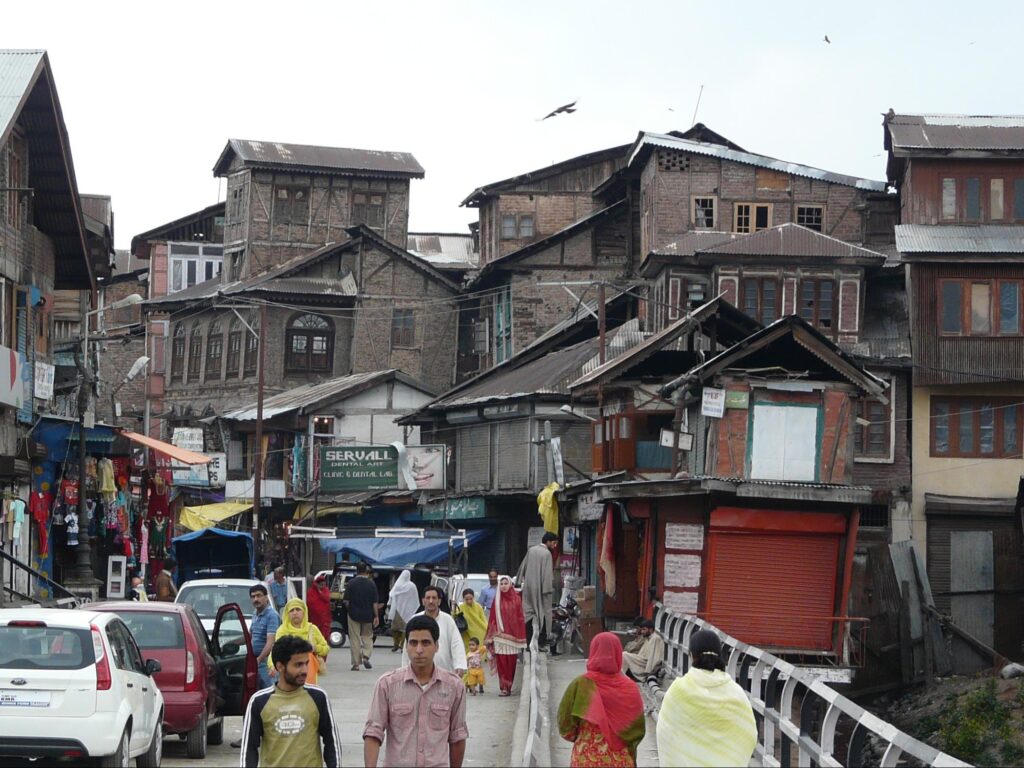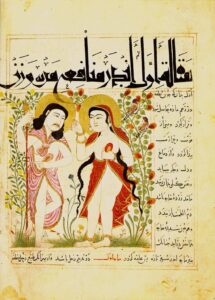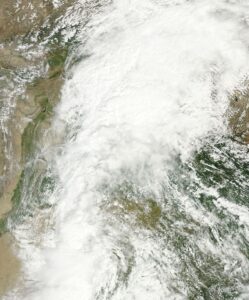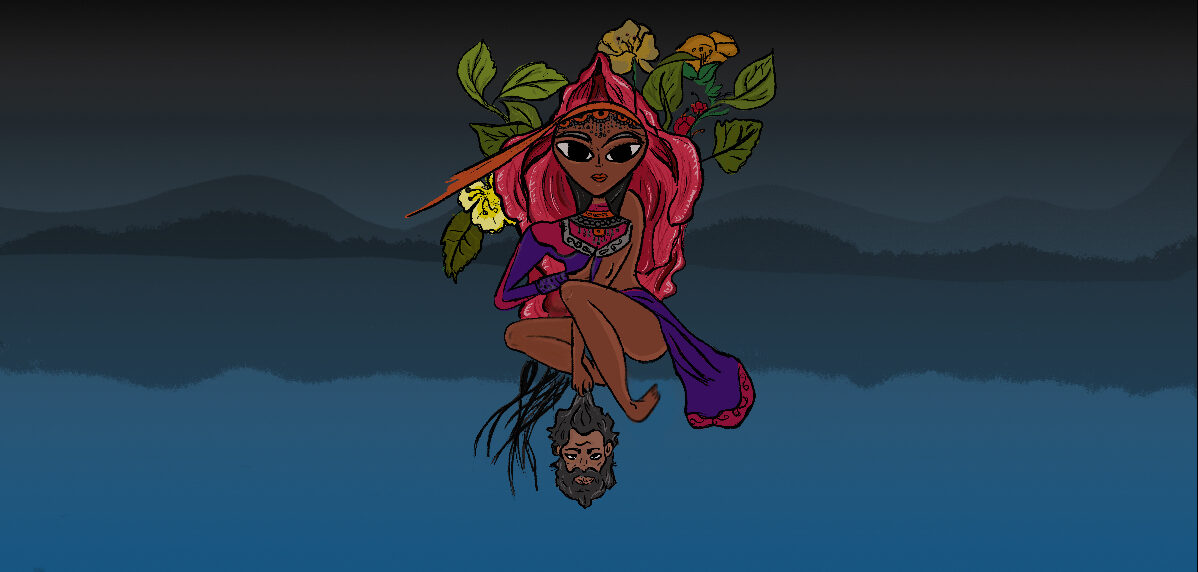Kashmir has a lot of stories to fill the long winter nights. As we tell them, numerous ghosts and demons leap from our collective unconscious.

Bram Bram Chok has fire on his head. He leads travelling men into the human-less parts of the night; the fire on his head appears like the lights of a town to men now travelling further from one.
Wai-Wuphf’s call is only two and a half words long. You can take away his cap and hide it somewhere: he will then stalk your house and try to take it back. Like many others, my father’s uncle claimed to have stolen his cap and kept it locked in a sandooq (an ornate wooden chest). Seasons passed, another winter came. One day in a hurry, he forgot to lock the sandooq. Not wasting a moment, the Wai-Wuphf came and took back his cap.
These encounters between the human and the non-human are not entirely joyless—their primary aim is to thrill, they tell the story of a contest between two species acting out of their nature. That changes with a Rantas. She is perhaps the most famous creature of them all.
How do you tell the difference between a Rantas and a regular woman? Her feet are inverted—her front legs end in ankles, her feet extend towards the back. Like Medusa, her hair is long and striking and that is where her power is said to reside. Her power, in its entirety, seems to be that she deceives.
She lurks on moonless and winter nights to charm and trap men with her song, all the while hiding her demon self. She takes men into the heart of the jungle and forces them to become her lovers under lock and key. At the faithful end of every tale, where the imprisoned man overcomes the Rantas, a graphic scene is laid out—her hair is cut and she is pushed into a furnace where she burns. The man then absconds from the forest, as her grotesque wailing thins with the distance.
In Morocco lives a similar tale—that of Aicha Kandisha, a libidinous female demon with a curvaceous body. She assaults men in streets and dark places, forces them to have intercourse with her, and traps them afterwards.
In both these tales, the she-demon physically overpowers and entraps men to fulfil her otherworldly carnal desires. Soon enough, one finds out everything that is true for the women caged in these tales is true for the women outside of the tale. The self is the story—if the woman didn’t exist, the myth wouldn’t either.
Folktales remain important sites where power dynamics between genders are created and consolidated. The many possibilities of Rantas, the fallen woman, Kashmiri populate folk tales. They follow a stock formula; often hidden in them lie the eternal causes of the transgressions populating a woman’s life. The Rantas is ever-present as a cautionary tale for women against their own bodies and instincts—portrayed on the verge of the irrational, they always threaten to spill out. The myth of the Rantas tells Kashmiri girls and women: beware of yourselves.
⚘⚘⚘
Cultural narratives leave residual memories that are influential in building the public code of conduct: you do not ever start from zero, you are being judged by the actions of trans-historical figures from myths, folktales, and religious scriptures. Narratives are the rigid, ever-tailing shadow of the Body, ever-undefined.
In Beyond the Veil, sociologist Fatima Mernissi argues that in Morocco, castrating females is a legacy of Aicha Kandisha. This practice extends to the millions of women in countries from Africa, West Asia, and South-East Asia that are subjected to Female Genital Mutilation (FGM), the severity of which varies. FGM can involve removal of the clitoral hood or labia, or sewing the vagina tighter. In some cases, cauterization, scraping, and piercing takes place too.

Some girls die during the procedure due to blood loss, tissue swelling, and blood infections. If they don’t die, sex is painful, childbirth is painful: what is left on the site of the body is a spot of perpetual unease and pain.
Says Sigmund Freud: women are passive vessels, and using their clitoris to seek pleasure for themselves will create fissures in their identities. Women’s identities must be rooted in ignorance of their bodies and the denial of pleasure.
Perpetrators of Rantas are in unison with Meister Freud. They vibrantly condemn any identification, imagination or articulation of womanly desire—professing that it is contrary to womanhood. All imaginaries of desire in women need to be cut at the root and made extinct. What Rantas inspires is a Freudian castration—the elimination of clitoral sexuality as a necessary precondition for femininity, a practice based on reduction.
To make a woman’s body foreign to herself under this project, various binaries are put into place—good and bad, virgin and prostitute, covered and naked, of the house or of the market, regular woman or Rantas. Binaries that would be valid for food—like fresh and rotten, or pure and impure—are applied to women. Binaries create two neat files, anything that cannot be subsumed under the good category will be shunned to the bad one. They keep your mind occupied—are you moulding yourself according to the binary or fighting it?
⚘⚘⚘
If a woman exists in a folktale, a key element of her role is to take the plot forward, often through her foolishness or depravity. In Kashmir, as is the case anywhere, a woman’s actions are condemned in many legends beyond the Rantas.
For example, a popular Kashmiri folktale tells the story of Gul Noor, wherever he sits and laughs, flowers bloom. On hearing this, the King of the day invites him to the palace so he can see the miracle unfold in front of his eyes. While on the journey to the palace, Gul Noor finds out that his wife is having an affair. His heart full of grief, he cannot bring himself to laugh. Angry at this, the King accuses him of spreading falsehood and Gul Noor is imprisoned. In other words, the miraculous Gul Noor is imprisoned because his wife breaks his heart.

Another famous folktale is that of Himal Nagrai. The story starts with a husband hatching a plan to kill his wife because she nags—the ‘nagging wife’ is a common joke that husbands make in households, an integral part of a husband-wife dynamic, and a very telling one at that.
The interpreters of these stories are the ubiquitous doctors—not always of the medical variety—who keep you under constant supervision for your affliction of being a woman, and give themselves the liberty to name and pronounce a cure for your condition. This condition, bearing a likeness to chaotic and untamed Nature, also came to be called hysteria in some cultures. It justifies the tacit control and concrete punishments meted out in case women fail to fall in line.
⚘⚘⚘
The fetish of veiling and the phobia of Rantas are deeply connected.
Rantas is of the forest, of Nature, two things that need to be tamed. The disconnect between woman and Nature is prolonged—she is kept away from it, where her instincts may run free, where her transformation into a Rantas may be realized.
Through Rantas, we see how overarching mythical and religious narratives exert overwhelming control over society, implicitly subsuming the body under the purview of speech and language. You fail as you try to trace a myth or its morality back to a person: it exists everywhere like the air and transcends time. No one can quarrel with something that transcends time.
But, within myths, pasts, presents and futures also co-exist as bundles, creating interpretations that lead to predictable effects. They tend to obliterate the ‘I think’—so, ‘I think this is right’ is replaced with ‘this has always been right’. This aspect of legends incapacitates the language of the disadvantaged—they are controlled into silence by the omnipresent myth.
One way in which the Rantas and other such cultural beliefs control women’s bodies in Kashmir is through how they navigate the world around them. Just like the Rantas, the conduct of female bodies in public is strewn with meanings and judgements—a language unfolding in space.
This calls for segregation, birthing a careful, calculated presence of women in public space. Multitudinous rulings about propriety and impropriety build a space of gendering replete with concrete rules and punishments. Even in the absence of an actual man, women move in public as if the male eye was watching.

When a girl hits puberty, she is taught to drape her growing breasts. Older women are encouraged to wear looser clothes to maintain invisibility, a vagueness of form, in the public eye. This vocal discussion on what a woman’s body cannot do is what enables the strict redaction of their physical form.
However, the public sphere does not end outside the home—it extends to the shared spaces at home, frequented by relatives, neighbours, and friends. This limits women further to a private space, a room of their own, if they have one—after all, a perfect veiling requires endless money.
But, even in this place of total aloneness, their bodies are already male spaces par excellence, because women are encouraged to not know their bodies in their private thoughts and own languages. Even in isolation, we are defeated. Extreme surveillance is deemed necessary to achieve the ideal state of existence of a female body.
⚘⚘⚘
Myths like that of Rantas expand to fit linguistic hierarchies, they are not egalitarian in their application to the deeds or misdeeds of women. If you are speaking loudly, writing loudly, walking loudly, or fighting loudly, or if you are not absenting yourself as required by the spatial language of propriety laid out for you, you are a Rantas. You can also be called a Waatij or a Gujjar Baaye—the names of two oppressed caste communities in Kashmir. Our lexicon allows the languages and biases of both the living and fantastical to become synonymous.
Norms of a ‘polite’ society demand that the body is kept out of the purview of conversational language—this is how the physical castration of women extends itself to language. As you go up the rungs of the class and caste ladder, the mention of a female body becomes less and less frequent, and the position of absolute silence on the subject becomes aspirational. Upper caste use of language is strictly draped and ‘refined’—the more formal, the less talk of body.
This redaction extends to speech and writing as well. We are not encouraged to know the names of ‘the parts’ that exist on our own bodies; the names vibrantly populating the realm of curses fail to find a life outside of them. We are denied the simple knowledge of our own bodies.
While growing up in Kashmir, I learned the names of body parts in English, a language that does not fill my home or alleys yet, a language that does not know the name of my favourite foods, flowers or trees. I could not survey my body from head to toe and know the name for everything, many parts were out of reach, they eluded the language that was taught to me. Sometime after I turned twenty, I looked up the names of my body parts in Kashmiri on Google. Later, I would have to incessantly repeat their names like a child to cultivate this estranged anatomy in my consciousness. Hair is mas, tongue is zev, fingers are ongji; hair is mas, tongue is zev, fingers are ongji, nails are nam, shoulders are shaane; hair is mas, tongue is zev, breasts are bab, hips are zeer, cunt is goodh, legs are zange, feet are khorr, then nam, nails again.
⚘⚘⚘
In a politically repressed land like Kashmir, the body of a beleaguered nation becomes the body of a woman, mauj kasheer. The land becomes a woman who through occupation is raped; the motherland needs to be protected from this defilement. The fight over a woman’s body—the purity and impurity of it—becomes an integral part of the power dynamic between the State and the People.
Yet, the symbolic fight over the purity of the body of the nation again plays itself out on the body of every woman. The mass rape of at least 23 Kashmiri women by Indian Armed Forces in Kunan-Poshpura—for which no judicial verdict has been arrived at for close to three decades—is a horrific incident, no doubt. But, it is made the beating heart of a nationalist discourse because the defiled body of a woman is a potent symbol for the narrative of a nation.

The fixation with mutilation or physical harm is an integral facet of social control. The body of the Rantas dies in uncircumspect mutilation—she is always thrown into the fire.
This voyeuristic fixation with the mutilation of female bodies has a two-fold effect. First, it is a punishment imposed on women even before any act of deviance takes place. Second, it also reiterates the mortality and finiteness of a female body, compared to the immortality and infiniteness of a male body. Restricting female impulses to just the carnal sphere points to a firm belief in the inability of women to rise above themselves—the divine has always been out of their hands.
Only in one instance in the Quran does the archangel Jibreel Amin descend to tell Maryam, a woman, what God intends for her. Otherwise, only men were chosen to hear God’s words across the rest of the Quran. The receivers of God’s Message were always men. A legacy of that tradition is that, in the present, the interpreters of that message are mostly men as well.
The reflection that our use of language provides us with is that all other modes of existence, such as women’s, are mutilations of the primary state of being. This state, we are told, is what all the prophets and our sexless, genderless God belonged to. One would think God to be a new pronoun, a new referral that corresponds to what its nature is, the light of the heavens and earth. But, in languages without neutral pronouns like Kashmiri or Arabic, not once did this dilemma of which pronoun to use arise. The choice was simple: in language, God has comfortably been a man.
From this choice onwards, the communication occurred not between light and man, but man and man. This was followed by centuries of religious interpretations made by men.
⚘⚘⚘

There are similarities across the creation myths for the Abrahamic religions—Islam, Christianity, and Judaism. Yet, the Christian version of this story is often the most well-known in the English-speaking world. Adam and Eve, the first male and female humans of this world, are also the first to disobey God. Eve ate a forbidden fruit in the Garden of Eden, and through this act, “sin entered the world”.
But, in Islam, where the first humans are Aadam and Hawa, Hawa alone does not instigate the act of eating the forbidden fruit. In the Quran, unlike in the earlier Judeo-Christian versions, both Hawa and Aadam jointly decide to eat the fruit forbidden to them, losing their claim to the garden of perpetual bliss and flowing rivers, high mansions, cups full of wine and the right to a labour-less existence.
Despite this, where I grew up in Kashmir, the burden of the fall interestingly fell on Hawa alone. The narrative remains that God made Aadam out of clay, and asked all the angels to bow to him. Hawa was created out of Aadam’s rib while he was asleep. Of the curved rib, Hawa, destined to remain crooked, ate the fruit first and lost them both paradise.
Every removal from paradise thereafter will always be the work of the descendants of Hawa, a re-enactment of the same nature and scene. In popular Kashmiri imagination, Hawa remains the instigator of the fall, the beginning and promise of the enormous burden of a woman erring.
An echo of this re-enactment took place in Kashmir in 2014, when the flood came. Much of the valley was submerged; people rushed to the upper stories of their houses, others fled to the countryside till the sky calmed down.

In the months that followed, new rebuttals emerged, marring the language for space: the flood did not happen because of the reckless urbanization on the banks of the river Jhelum, or the loss of wetlands in the area.
It happened because of the promiscuity of girls—this re-application to the flood had everything to do with uncovered hair, for example, a sin great enough to lead to the destruction of a people. Unlike the Quran, where everyone was punished for engaging in sin and refusing to accept a prophet’s message, this flood was only caused by untoward female behaviour. We were all complicit in stealing the sun from the sky for seven days, for letting loose enough rain to drown the world.
It was as if Hawa herself had pulled the Jhelum by hand and caused it to flow with all its life towards where people lived. This is how we witnessed the altering of a story.
⚘⚘⚘

The need of the hour is to divorce Rantas from her meaning. The otherness of Rantas is a resounding reiteration of the otherness of femininity. This otherness is constructed by masculine hands, stretched to an uneven degree: from the distortion of her features to the disintegration of her body, Rantas is caught in a very ugly meaning. All of her motivations align towards the thrust of her entire existence: a libidinal gratification. If anything, what this reveals is—in society, there exists a great will to control female desire.
Many cultures have a staple female demon figure that results from such a construction, many of them are known for showcasing lesser emotions such as cruelty, jealousy or revenge. In Latin America, the tale of La Llorona is of an evil or failed mother who can be heard weeping into the night for drowning her children. Bean Sidhe of Ireland also wails into the night—her appearance is tied to the impending death of a loved one. These folktales or myths purporting a wicked sense of femininity are successful in trapping women in pre-defined roles.
Moreover, a popular figure like Rantas that is easily accessible to children of all genders in Kashmir, plays a great part in how femininity continues to be construed. An essential element of how to change the real remains understanding how to change the story: the implication of ‘stories’ cannot go unexamined from generation to generation. We have to let Rantas out of her crushing moral cage.
Featured image: a Rantas, illustrated by Nainika Dechamma.







เขาหิมาลัย
The conditions under the deep sea were completely dark. Temperatures near freezing point and pressures that can be 1,000 times greater than atmospheric pressure at sea level. These extreme conditions have led to unique evolution. As a result, the deep sea is home to some of the strangest and most mysterious creatures on Earth.
ฉลามบุก
During an expedition off the coast of Chile Scientists have discovered more than 100 new species of animals living on underwater mountains. The discovery of this incredible discovery occurred along the ridge. ‘Salas y Gómez, an underwater mountain range that stretches 2,900 kilometers between Chile and Easter Island. The discovery reveals the biodiversity hidden in the ocean at depths of up to 3,530 meters above sea level.
An international team of researchers supported by the Schmidt Ocean Institute has been exploring the deep sea using underwater robots. in an area that has never been surveyed before, covering an area of 52,777 square kilometers. through data collection Map the ocean floor and underwater mountain ranges Until finally, they found a deep-sea ecosystem that has biodiversity in extreme conditions that humans cannot reach.
good